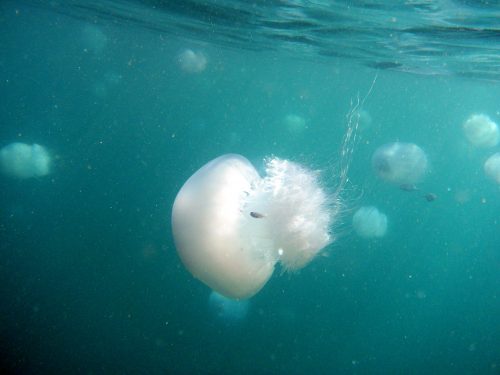A study conducted by scientists from the Technion and the University of Haifa explains for the first time the unique burning mechanism of the wandering filament.

The amount of jellyfish in the world and in the Mediterranean Sea is constantly increasing, and as a result, every year we encounter large swarms on the shores of the country. The most common jellyfish in Israel is the wandering jellyfish (Rhopilema nomadica) which arrived in the Mediterranean Sea in the seventies.
The jellyfish belongs to the stingray family - animals that attack their prey (plankton) and defend themselves with stinging cells that contain syringes that are actually poisoned arrows. Although they do not have eyes, ears and even a brain, they have survived for 600 million years, with almost no developmental changes, thus being one of the oldest complex creatures that have not become extinct to this day.
Research conducted at the Technion explains for the first time the unique burning mechanism of the wandering filament. According to Prof. Uri Shavit from the Faculty of Civil and Environmental Engineering at the Technion, "The jellyfish attacks its prey or its enemy by injecting a toxic substance through thousands of microscopic syringes located on each of its arms. Inside the burning cell called a nematocyte is the syringe needle, packed and folded into itself in a spherical capsule with a diameter of about 10 microns. In response to chemical changes in the environment or to physical contact, the pressure in the capsule increases and the needle shoots out with an enormous acceleration of more than 107 meters per second squared - several times the acceleration of a rifle bullet."
The firing mechanism of the needle, from a folded state inside the capsule to its full extension, occupies many researchers around the world. The accepted explanation holds that the needle is pulled out and shoots the toxic substance following the formation of a force called osmotic potential. This force pushes the needle and the liquid similar to a pump pushing water up a building. The pressure applied in this process is enormous - 150 atmospheres. To explain the ear, this is the pressure required to raise water to the edge of a building one and a half kilometers high.
But in the study now published in the journal Journal of the Royal Society Interface It was found that the driving force is not limited to the capsule only. In fact, it is a tremendous osmotic mechanism that develops at the moving end of the needle. This mechanism releases the needle and pulls it after it, similar to a locomotive pulling wagons.
The research is based on measurements in Lab-on-chip technology and the development of a mathematical model that follows the movement of the material within the system. The lengthening mechanism of the cautery needles was deciphered by Prof. Shavit with Professor Gilad Yousiphon from the Faculty of Mechanical Engineering at the Technion and with Dr. Tamar Lotan from the Charni School of Marine Sciences at the University of Haifa.
The solution was provided by an experimental system developed on the basis of a microfluidics platform in Prof. Yousiphon's laboratory. This system allowed the researchers to route the needle and its direction of penetration.
Prof. Shavit explains: "Each capsule is placed in the opening of a micro-channel that connected a central water channel to another channel that contained oil. We found that when the needle penetrated through oil, its elongation rate decreased by three orders of magnitude - from 50 milliseconds in water to about 25 seconds in oil."
The researchers concluded that, contrary to the conventional model, the osmotic phenomenon is not limited to the capsule but occurs throughout its operating environment. According to Prof. Shavit, "The meaning is that it is possible to influence the osmotic potential along the path of the needle's progress and thus reduce its ability to penetrate the skin and prevent the burn."
for the article in the journal click here
See more on the subject on the science website:
